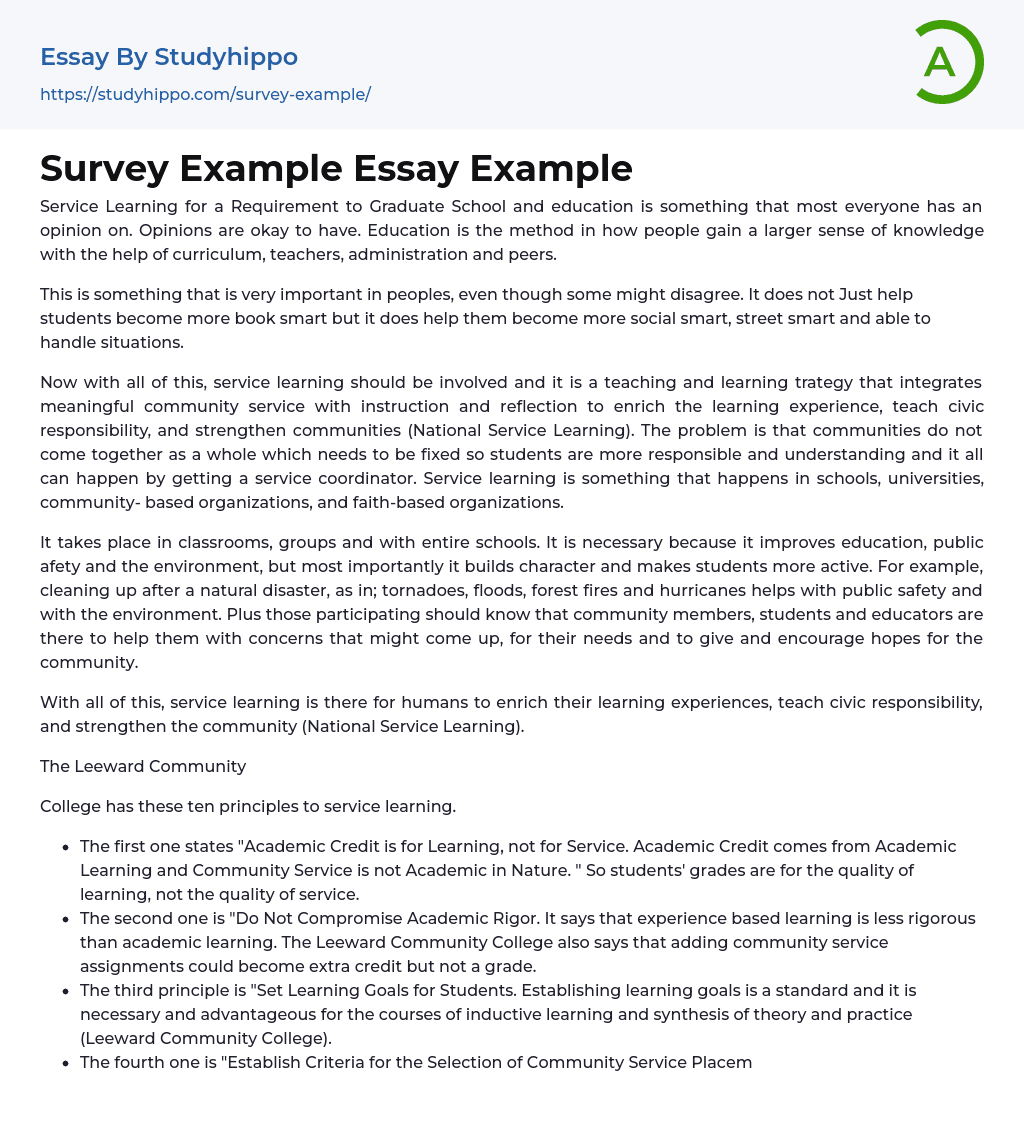There is debate regarding the inclusion of Service Learning as a requirement for graduation. Nonetheless, education serves as a foundation for individuals to acquire extensive understanding through the curriculum, teachers, administrative personnel, and classmates.
Service learning, as defined by National Service Learning, combines community service, instruction and reflection to improve education, encourage civic responsibility and support community development. However, the challenge is that communities are divided which results in students lacking accountability and comprehension. To tackle this issue, employing a service coordinator can be advantageous. Schools, universities, community-based organizations and religious institutions all embrace service learning.
Improving education, public safety, and the environment requires efforts at the classroom, group, and school-wide levels. To promote student activity and character building while achieving these go
...als, students can participate in activities related to natural disaster clean-up such as tornadoes, floods, forest fires and hurricanes. These efforts enhance public safety and the environment while fostering a sense of community among students and educators. By supporting each other's needs in this way, hope for the future is instilled.
The National Service Learning declares that service learning aims to improve human education, promote civic duty, and strengthen the community. The statement is displayed as a justified paragraph with .
The Leeward Community
The principles of service learning in college comprise ten points.
- The first one states "Academic Credit is for Learning, not for Service. Academic Credit comes from Academic Learning and Community Service is not Academic in Nature. " So students' grades are for the quality of learning, not the quality of service.
- The second one is "Do Not Compromise Academic Rigor. It says tha
experience based learning is less rigorous than academic learning. The Leeward Community College also says that adding community service assignments could become extra credit but not a grade.
Cole. " It says that classroom and community are two different ways of learning. It should not conflict with learner role expectations and if students want to do community service, they must make it for it. They also say the more community service, the better chance of potential.
During their stay, they can expect to complete ten hours of community service.
Community service hours are a necessary requirement for high school graduation, even during middle school. A club that focuses on community service creates care packages for overseas soldiers, collects Christmas presents for children in the community, and brings holiday spirit to assisted living communities by caroling (Carroll County Public Schools). If the community service is related to a
course, it is recorded on the transcript and can be transferred to other schools along with the student.
Numerous educational institutions permit specific high school courses to be counted towards service hours.
The Carroll County Career and Technology
Roughly 30 middle and high school opportunities are available at Center. Meeting the goal earns students the Exemplary Service Award, but many exceed the required amount and double their efforts.
Now the Maryland State
- First, is to meet a recognized need in your community.
- Second, achieve some curricular objectives.
- Third, reflect throughout experiences.
- Fourth, develop student responsibility.
- Fifth, establish community partnerships.
- Sixth, plan ahead.
- Seventh, equip students with the knowledge and skill needed (Carroll County Public Schools). Now looking at what Duke University does. In 1999 Dean's advisory committee adopted this definition at Duke.
- "Service learning links classroom learning with service to communities. Service opportunities are developed through collaboration among faculty, students, and individuals and organizations in the community. Service lacements are designed to meet two criteria to enhance the educational goals of a course and to serve the public good by providing a needed service to individuals, organizations, schools or other entities in the community.
Service learning students dedicate themselves to participating in a service project or accomplishing a predetermined amount of service work.
According to Duke University, service-learning can greatly improve students' comprehension of an academic field or topic by offering hands-on opportunities to develop leadership and life skills, as well as prompting critical reflection
on individual, institutional, and social ethics.
On average, people believe that education provides various benefits, including increased opportunities, assistance with doubts and criticisms, and motivation for students to engage more actively in the school system. According to Danny Weil's "Early Relevance" theory, teachers should not focus on memorization but instead challenge their students with real-life situations. In 2003, Anderson and Erickson found that approximately 59% of teacher education programs include instruction about service learning and provide strategies for teachers to implement it in their classrooms.
According to National Service-Learning, only about 24% of the programs provided to teachers offer opportunities for service-learning engagement among teacher candidates. Similarly, around 18% of the programs aid in the development of lesson plans that incorporate service-learning. Around 20% of teacher candidates were given internships with other teachers that have actual experience with service-learning. However, in 2000, Furco and Ammon's findings in California showed that many teacher educators were unsure about the specifics of service-learning and often confused it with student teaching.
- Interpretation essays
- Plagiarism essays
- Analogy essays
- Learning English essays
- School Types essays
- Peer Group essays
- Coaching essays
- Critical Thinking essays
- homework essays
- Learning essays
- Library essays
- Listening essays
- Literacy essays
- Mentor essays
- Physical Education essays
- Project essays
- Reading essays
- Research essays
- Sex Education essays
- Social Studies essays
- Standardized Testing essays
- Study Plan essays
- Teaching essays
- Classroom essays
- College essays
- E-Learning essays
- Elementary School essays
- Examination essays
- Graduate School essays
- High School essays
- History Of Education essays
- Homeschooling essays
- Kindergarten essays
- Middle School essays
- Public School essays
- School essays
- Single Sex Schools essays
- Special Education essays
- Student essays
- Teacher essays
- University essays
- Vocational Education essays




